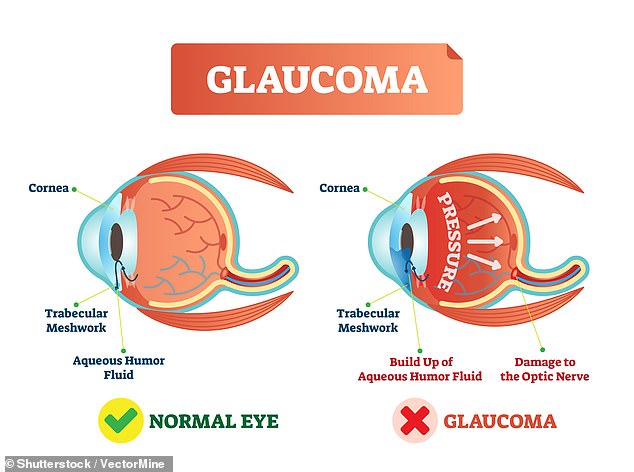The common sight condition that can make you see SNAKES, bugs and cockroaches
A man who experienced visions of giant cockroaches and snakes was found to be suffering from Charles Bonnet syndrome – a common condition that causes hallucinations in people with impaired vision.
The 78-year-old man had no history of mental health problems, but told doctors he saw insects and snakes growing in size and multiplying in number.
He also said he felt insects crawling on him and he swatted at them and scratched his skin intensely. Eventually, his hallucinations became so severe that he called a service to eradicate the pests he thought were invading his home.
The man had previously been diagnosed with glaucoma, a known cause of visual disturbances, leading doctors to conclude that his hallucinations were due to Charles Bonnet syndrome.
When vision is impaired, the brain does not receive as much visual information as it is used to. To compensate, it fills in the gaps with images of things that aren’t really there

Nearly three percent of people with glaucoma have Charles Bonnet syndrome, and as many as 38 percent of people with some form of vision disorder experience visual hallucinations
Eye health experts and neurologists believe that Charles Bonnet syndrome results from dysfunctional communication between the eyes, which collect visual information, and the brain, which receives and interprets that information.
When the eyes cannot effectively see everything around them, the brain fills in the gaps with images that are not there, such as people, animals or objects.
Glaucoma, a progressive eye disease that affects three million Americans, can lead to Charles Bonnet syndrome, and nearly three percent of people with the eye disease develop the syndrome.
The unnamed patient, who was the subject of a case reportsuffered more intense hallucinations as his vision deteriorated.
What started as minor disturbances in one eye spread to both eyes and what he saw and felt became more and more intense.
Charles Bonnet syndrome can be mistaken for mental health problems such as schizophrenia, which causes a distorted sense of reality, visual and auditory hallucinations and delusions.
About a month before seeking professional help for his hallucinations, the patient said he was treated with an unknown injection into his eye to try to correct his vision loss.
The visual disturbances first appeared in the man’s right eye and started as squiggly objects that would disappear when he closed his eyes.
Then he started seeing and feeling insects.
His hallucinations were visual and tactile, but he heard nothing and saw nothing while he slept.
Neurological examination showed nothing remarkable that could explain the strange visions the man was seeing.
Still, neurologists recommended an eye patch for his right eye where the hallucinations began, and a daily dose of an antipsychotic drug called risperidone, which helps people with schizophrenia and similar mental disorders with hallucinations.
Doctors will decide on a case-by-case basis whether to prescribe antipsychotic medications for Charles Bonnet while the medications have shown benefit in individual patients, there is little evidence to support its use as a standard drug for treating the syndrome, and the benefits of its use may not outweigh the risks of side effects or interactions with other medications.
Although the man did not respond exceptionally well to antipsychotic medications, these are the typical methods of treating Charles Bonnet.
However, the man’s condition deteriorated. He punched the walls with the aim of killing the insects or swatting them through the air, believing they were invading his home and the inside of his eyes, a feeling known as delusional parasitosis.
He was switched to two new medications, including one for depression and anxiety, which helped a little but did not provide complete relief.
Overall, Charles Bonnet affects between 10 and 38 percent of people with vision problems, although it is most common in the elderly, who are especially prone to degenerative eye diseases such as glaucoma and macular degeneration.
People with Charles Bonnet usually know that what they see is not actually happening once it is explained to them.
This is one of the criteria for diagnosing the condition, along with having at least one complex hallucination in the past four weeks, having visual hallucinations without hearing things, and the absence of delusions, which indicate a psychotic disorder could indicate.
The 78-year-old sometimes insisted to doctors that the insects he saw were real, but at other times he understood that they were part of a hallucination.
The doctors said: ‘Our patient had partial insight upon initial presentation. The partial insight gradually began to disappear as his hallucinations worsened and his thoughts about parasitic infestations became more fixed, intense, and delusional in intensity.”
The patient was instructed to contact a psychiatrist, a therapist, a general practitioner and an ophthalmologist. It is not clear from the case whether the patient did this.
